|
- Catalog (in stock)
- Back-Catalog
- Mail Order
- Online Order
- Sounds
- Instruments
- Projects
- History Face
- ten years 87-97
- Review Face
- our friends
- Albis Face
- Albis - Photos
- Albis Work
- Links
- Home
- Contact
- Profil YouTube
- Overton Network
P & C December 1998
- Face Music / Albi
- last update 03-2016
|
1. Tsagaan zagal mori, white-brown horse – short song (bogino duu) – 1:37
2. Bor boriin byalzuukhai, little yellow-brown bird – long song (suman urtiin duu) – 17:15
3. Samriin gurvan tolgoi, the mountain with the three tops – short song (bogino duu) – 3:21
4. Aranjidmaa – short song (bogino duu) – 2:26
5. Khatir – ring dance (johor dance) – 2:12
6. Uvgun shuvuu, the old bird – long song (aizam urtiin duu) – 8:21
7. Ekhiin duu – lullaby, short song (buuvein bogino duu) – 3:23
8. Saikhan khangain buga, stag of the beautiful mountains – short song (bogino duu) – 2:43
9. Bukuujuu gelgui yakhav, first love – short song, (baruun bogino duu) – 2:27
10. Shigshirgiin ai, when a horse moving fast – short song (bogino duu) – 1:38
11. Taliin tavan tolgoi, the mountain with the five tops – short song (bogino duu) – 2:35
12. Goolingoo – short song (bogino duu) – 5:43
13. Nogoon dari ekhiin Burelvaa, Burelvaa the Green Tara – magtaal (praising song) – 3:15
14. Altan noyon galuu khuu, the young golden prince Goose - fable – 9:43
The ensemble was founded in 1997. All its members have studied at the academy of music in Ulaanbaatar.
The Mongolians conferred the title Khan (Khan = King) to their highest-ranking ruler (tribal chief) of the tribes. Undur Gegeen Zanabazar was the first Bogd (1635-1723), this high-ranking Buddhist monk ruled from Urga*, the historic capital of Mongolia. He was a highly acclaimed monk and statesman, and he was also Mongolia's greatest artist. The Mongolians called their greatest khan ever, the conqueror Chinggis Khan, Bogd Ezen (Holy Lord). In the Mongolian language this designation is also used for important or holy mountains or even whole mountain ranges.
|
*Ulaanbaatar has had numerous names in its history. From 1639–1706, it was known as Örgöö, and from 1706–1911 as Ikh Khüree. Its Chinese name was Kulun. Upon independence in 1911, with both the secular government and the Bogd Khan's palace present, the city's name changed to Niislei Khüree. Ulaanbaatar was usually known as Urga.
When the city became the capital of the new Mongolian People's Republic in 1924, its name was changed to Ulaanbaatar ("Red Warriors" or "Red Heroes"), in honour of Mongolia's national hero Damdin Sukhbaatar, whose warriors liberated Mongolia from Ungern von Sternberg`s troops and Chinese occupation shoulder-to-shoulder with the Soviet Red Army. His statue still adorns Ulaanbaatar's central square. |
There are performed short songs (bogino duu) and long songs (urtiin duu), with the female voice assuming an important role. The songs are about nature, man, animals (especially the horse) and the land of the Mongolian in general.
|
| Urtiin duu (long song) melismatic and richly ornamented, with a slow tempo, long melodic lines, wide intervals and no fixed rhythm. |
It is sung in verses, without a regular refrain and with a full voice in the highest register. The melody has a coat, which covers three octaves. This requires a strict observance of the breathing rules. The breathing is actually free, but the singer has to keep the strict rules of performance, making only the absolutely necessary breathing breaks without interrupting the melodic ornaments. The richer the voice is and the longer the singer can hold it, the more intensive is the attention paid by the audience and the more appreciated is this performance.
People usually practise these long songs while being alone in the open steppe and slowly riding along. The repertory is an expression of the liberty and the vastness of the Mongolian steppe and is used to accompany the rites of the seasonal cycles and the ceremonies of everyday life. Long songs are an integral part of the celebrations held in the round tents, and they must be sung following the strict rules of performance. |
|
|
Besreg duu - the shortened one have short verses, refrains, and melodic courses full of leaps and bounds. |
|
Bogino duu (short song) - strophic, syllabic, rhythmically tied, sung without ornaments. |
|
Short songs are never sung at celebrations, since they are spontaneously improvised and rather satirical. They are often sung in the form of a dialogue and speak of certain friends and incidents, or they are lyrical tales about love, about everyday life and about animals, especially horses. |
The Mongolian songs have a rich repertory. Music spread from ger to ger on the occasion of festivities and by way of teaching. The family or the clan meeting constituted a good opportunity to gather and sing together, the chance to learn from others, and to take home a new melody. In this way, the ancient patterns performed in various corners of Mongolia have been preserved by local masters for the whole nation.
The nomad shepherds in Mongolia, like other nomads from Central Asia, used to play string and wind instruments. The national music of Mongolia has had a rich background and a great tradition that goes back many centuries. Ensembles (orchesters) have performed at court or in the monasteries for lamaistic celebrations or in ritual ceremonies. Ensembles also play for daily rites in the ger (yurt – round tents). The morin khuur (horsehead violin or 'fiddle') (morin = horse; khuur = sound, rhyme, melody) is the most important traditional instrument for dance and to accompany songs. It is the national instrument.
Songs
|
1. Tsagaan zagal mori, white -brown horse - short song (bogino duu) |
|
Traditional song from the Bayankhongor aimag in Southwestern Mongolia. |
|
- Nomin-Erdene Battulga: female voice, Togtokhjargal Buyankhishig: morin khuur |
|
A girl rides with her white-brown horse through snow-covered mountain ranges to the town in order to visit her mother living there. It snows heavily, and the horse gets whiter and whiter. The girl is well dressed, and has also made up herself for this visit. When entering the house, the door creaks. The girl is happy to see her mother in her old home. She wants to visit her ageing mother more frequently in the future; actually whenever it is possible; in spring, in summer, again and again, in all seasons. |
|
|
|
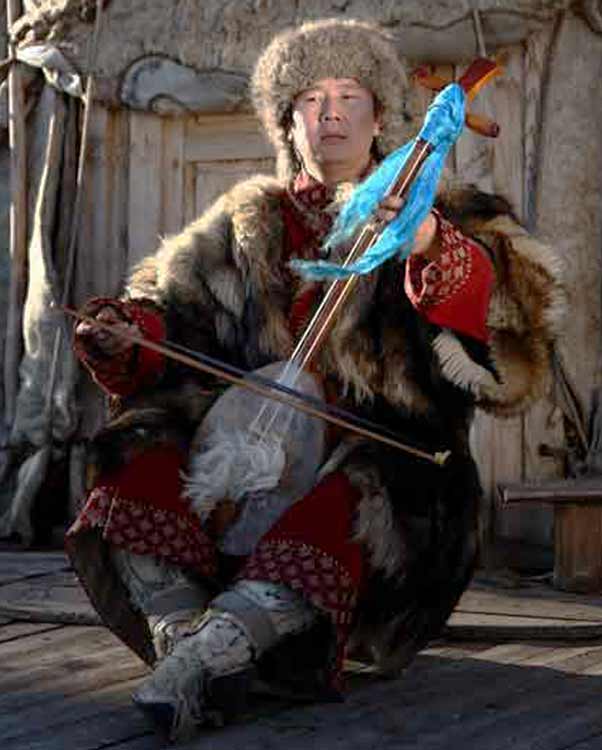
Togtokhjargal Buyankhishig: ikili, morin khuur and khun tovshuur |
|
|
|
2. Bor boriin byalzuukhai, little yellow-brown bird - long song (suman urtiin duu) |
|
Traditional melody from the Borjigin clan (Borjigid). The most renowned family in Inner Asia provided the ruling princes for Mongolia and Inner Mongolia and for the Kazakhs. |
|
- Nomin-Erdene Battulga: female voice, Togtokhjargal Buyankhishig: morin khuur |
|
A little yellow-brownish bird sits in front of the house and sings. |
|
A man misses his bride and has been drinking for the last two days and nights. His love is called Algiimaa and is of the same age as he is. She has moved far away to the Northwest, and he cannot visit her every day as he used to do.
The man sings about his love to the bride he misses, and he plans to visit her with the yellow-brown horse that would run in a smooth canter (joroo mori) and is decorated with silver harness (jiijuu silver khazaar). |
|
|
|
3. Samriin gurvan tolgoi - short song (bogino duu) |
|
- Nomin-Erdene Battulga: female voice, Togtokhjargal Buyankhishig: morin khuur, Uyanga Gankhuya: khuuchir, Solongo Gankhuyag: yatga, denshig |
|
Name of the mountain with the three tops (heads).
|
|
A nomad visits the girl he loves with his horse, and he rides to the mountains with the three heads where they will meet. They sit together and enjoy the beautiful time they are going to spend with each other.
This song is about the love of a young pair, which has agreed to meet there. They sing about the beautiful nature of their home country, of the landscapes and about their love. |
|
|
|
4. Aranjidmaa - short song (bogino duu) |
|
- Nomin-Erdene Battulga: female voice, Togtokhjargal Buyankhishig: morin khuur, Uyanga Gankhuya: khuuchir, Solongo Gankhuyag: yatga, rattle |
|
Guests are usually urged to drink three glasses of vodka at the occasion of a wedding or a party. Each person invited has to empty such a glass again and again and to issue a toast. It is obvious that at occasions like these, when there is drunk so much alcohol, wild fights are often the result.
In this song a youg women with the name Aranjidmaa sings about her loved husband who was sentenced to prison in a black yurt because he had been fighting when being drunk. .
But also the husband misses his wife, and he hopes that she will visit him soon so that he can tell her how much he loves her. It does not make sense to scream and shout, because she does love you, too, and she will visit you soon. |
|
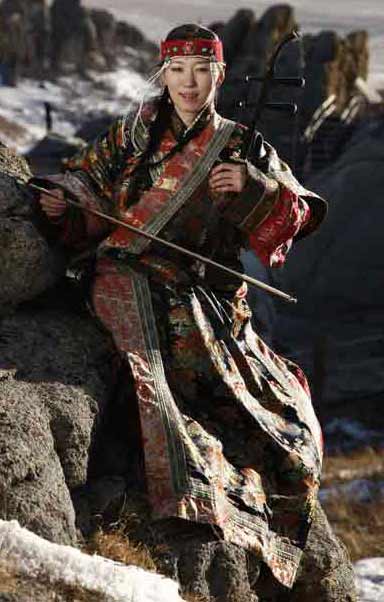
Uyanga Gankhuya: khuuchir |
|
|
|
5. Khatir - ring dance (johor dance) |
|
Traditional song from the Buryat tribe. This tribe performs this song and dances around in a circle, like horses do, faster and faster. This song, however, also has the meaning of friendship. |
|
- Nomin-Erdene Battulga: female voice, Togtokhjargal Buyankhishig: morin khuur, Uyanga Gankhuya: khuuchir, Solongo Gankhuyag: yatga |
|
On a little space, as big as a saddlecloth.
We dance around and around ... |
|
Only the Buryats cultivated the tradition of this ritual dance, and they wear their traditional costumes with the silver hair decoration. They do not dance uninterruptedly, but stop inbetween to chat, and they tell stories about their ancestors; in this way handing their own tradition down to the next generation. There is done a lot of dancing, singing and storytelling until the morning dawn. |
|
|
|
6. Uvgun shuvuu , the old bird - long song (aizam urtiin duu) |
|
Traditional melody from the Khalk tribe in Central Mongolia.
The old bird, a song by Danzanravjaa, a famous writer from the Gobi region. |
|
- Nomin-Erdene Battulga: female voice, Togtokhjargal Buyankhishig: morin khuur |
|
This song is about man and animal living together and their respect for nature.
The summer is always the most beautiful season in which man and animals, also wild animals, and also the birds enjoy this warm season. The birds sail in the wind - like the nomads moving around, moving around with their herds in nature. |
|
|
|
7. Ekhiin duu - lullaby - short song (buuvein bogino duu) |
|
Lullaby from the Zakhchin tribe in Western Mongolia. |
|
- Nomin-Erdene Battulga: female voice |
|
This song is sung from the view of a toddler that cannot speak but watches his surroundings rather carefully.
|
|
The life of the Mongolian women is a rather hard one. In the yurt, there have to be performed a lot of daily duties which include, among others, raising and feeding the children, cooking food, feeding the animals and milking them.
Also a young mother has to perform many heavy duties (carrying water, collecting dung, firing the oven, etc.).
The little one is crying because it is hungry; at the same time the mother's breasts hurt, milk is welling. It is time to feed the baby. The young mother knows that her baby misses her.
|
|
The mother sings, sleep, my son, sleep, but the little one keeps on crying, like a little bird hungrily waiting to be fed but whose mother is still far away in the woods searching for food. Sleep, my son, sleep ..... |
|
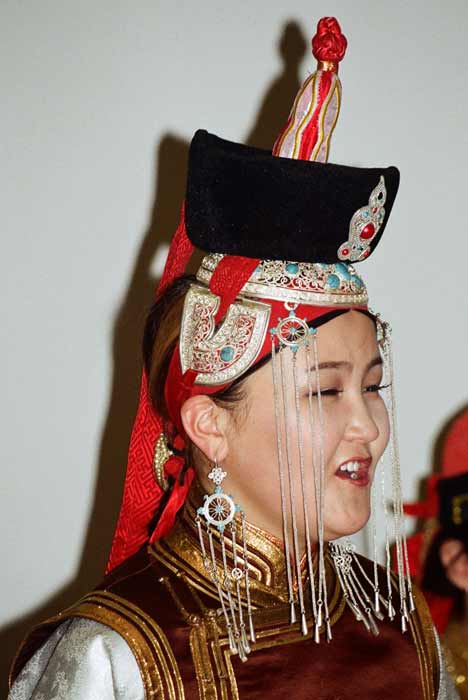 |
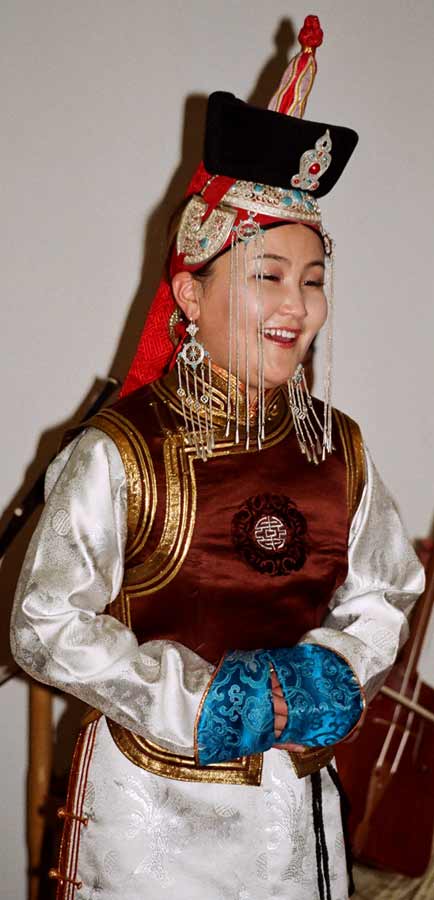 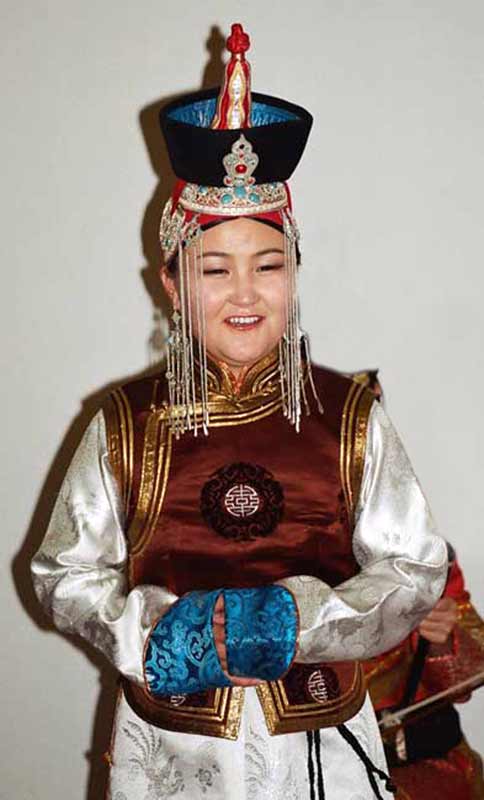
Nomin-Erdene Battulga: female voice |
|
|
|
|
8. Saikhan khangain buga, stag of the beautiful mountains - short song (bogino duu) |
|
- Nomin-Erdene Battulga: female voice, Togtokhjargal Buyankhishig: morin khuur, Uyanga Gankhuya: khuuchir, Solongo Gankhuyag: yatga |
|
If a stag senses that it is rutting season, it starts to bell and in this way tries to catch attention.
In this period of time, a boy longs for the love of his mother and remembers the happy times he has spent with his mother. |
|
|
|
9. Bukujuu gelgui yakhav, first love - short song, (baruun bogino duu) |
|
Traditional song from Western Mongolia. |
|
- Nomin-Erdene Battulga: female voice, Togtokhjargal Buyankhishig: morin khuur, Uyanga Gankhuya: khuuchir, Solongo Gankhuyag: yatga |
|
About first love. Many young people want to find a first love, and they also want to marry their loved one.
- Many vertebras. I want the red, choosing many men, but I only want to choose you.
- Ten vertebras. I want the white, choosing ten men, but I only want to choose you.
- Thousand vertebras. I want the brown, choosing thousand men, but I only want to choose you.
- Of all these, I only choose my loved Bukujuu. |
|
|
|
10. Shigshirgiin ai, when a horse is moving fast - short song (bogino duu) |
|
- Nomin-Erdene Battulga: female voice, Togtokhjargal Buyankhishig: morin khuur, Uyanga Gankhuya: khuuchir, Solongo Gankhuyag: yatga, percussion
|
|
Movement of the horse, it sounds like tarap....tarap.... It sounds like the play of this drum (Shigshirgiin).
The silver head decorations of the female rider form a harmonious sound with the movement of the horse, it sounds like the melody of the steppe. |
|
|
|
11. Taliin tavan tolgoi - short song (bogino duu) |
|
Traditional song from the Bayankhongor aimag in Southwestern Mongolia. |
|
- Nomin-Erdene Battulga: female voice, Togtokhjargal Buyankhishig: morin khuur, Uyanga Gankhuya: khuuchir, Solongo Gankhuyag: yatga |
|
Name of the mountain with the five tops (heads) in the southern part of the Gobi.
|
|
The husband of a Mongolian woman serves in the army. She misses him very much as five years are a very long time. For this reason, she dreams of him and of the horses in the steppe, and she thinks that she is going to marry him rather quickly when he comes back home.
|
|
The song is about the patience and discipline of a woman who waits for her lover. |
|
|
|
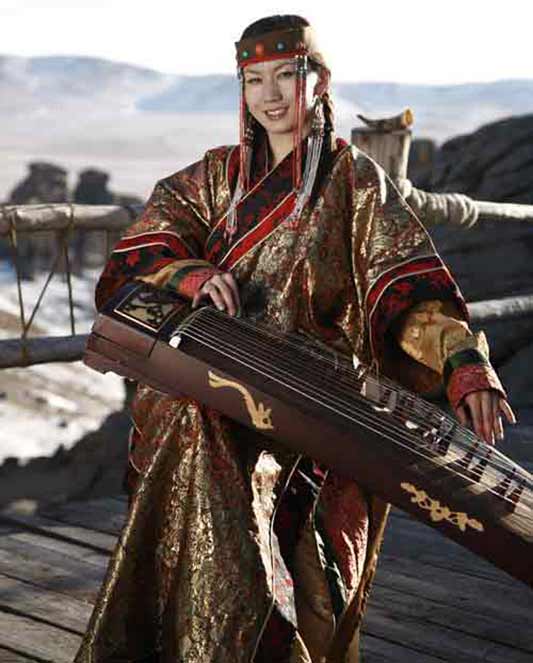
Solongo Gankhuyag: yatga
|
|
|
|
12. Goolingoo - short song (bogino duu) |
|
Traditional song from the Ikh Khüree time. Ulaanbaatar had numerous names during its history. From 1706 - 1911 there was the time of Ikh Khüree. The Chinese name of the town was Kulun. |
|
- Nomin-Erdene Battulga: female voice, Togtokhjargal Buyankhishig: morin khuur, Uyanga Gankhuya: khuuchir, Solongo Gankhuyag: yatga
|
|
In this song there are described the dreams of a young man about his love.
|
|
A young man dreams of his love Goolingoo, also when he is asleep, and he thinks about her all the time. He remembers her lovely words. During the day and no matter where he is, even in the mountains when he is with his horses and cows, she is always with him.
|
|
Old people are afraid that this is an ill omen, and, for this reason, it should only be sung for those already deceased. |
|
|
|
13. Nogoon dari ekhiin Burelvaa, Burelvaa the Green Tara - magtaal (praising song)
(shashin turiin khundetgeliin ardiin duu) |
|
Magtaal are sung in honour of the gods of Lamaism and the spirits of nature, heralds or in particular animals. Epic texts also contain praise songs for the mountains, the rivers, and nature in general. This is an ancient tradition still practised up to the present days by the tribes in the region of Mongol-Altai in Western Mongolia. |
|
- Nomin-Erdene Battulga: female voice, Togtokhjargal Buyankhishig: morin khuur, Uyanga Gankhuya: khuuchir, Solongo Gankhuyag: yatga, denshig, cymbals, damar
|
|
It is a praising song on the rebirth of the Green Tara. Two high-ranking Mongolian monks, who are considered to be the rebirth of the Green Tara, are honoured here in this song. |
|
|
|
14. Altan noyon galuu khuu, the young golden prince Goose - fable |
|
Heroic-epic song (tuuli) from the Khalk tribe in Central Mongolia. |
|
- Nomin-Erdene Battulga: female voice, khun tovshuur |
|
The young, golden prince Goose has a horse with wings. (Altan noyon galuu Khan khuu).
|
|
Once upon a long time, there was a stone castle at the end of the big ocean in which there was living the young, 15 years old prince Goose. He lived in a yurt (ger), the uppermost ring of which was held together by twelve struts decorated with corals, gems, silver and gold.
One day the young prince visited his father and asked him, "Father, what is my future?" The father then answered him, "You have to take care of 20,000 horses and you have to marry your future wife. She is a member of the family of the Genghis Khan line. She has black eyes, red lips, and she has become a beautiful young women. Now it is time to go and take her home."
The prince follows his father's advice and takes this young bride home into his yurt. But he does not spend nine days with her alone, he has also taken his horse into the yurt (ger).
After some time the father visits his son and asks him, "Why don't you take your horse back to the herd? In the yurt (ger) it will only wither. If you do not need your horse, take it back to the herd, so that it can enjoy the pastures and so that the herd is thriving."
And really, today the prince admires his best horse that happily enjoys with the other horses of the herd the steppe like a free bird. Now the prince saddles his horse and rides with his horse into the steppe - as fast as the wind. His subjects admire his good horse, which has become a wonderful part of the herd and such a good horse. The prince loves his faithful horse, such as he loves his bride, and he remains happy forever. |
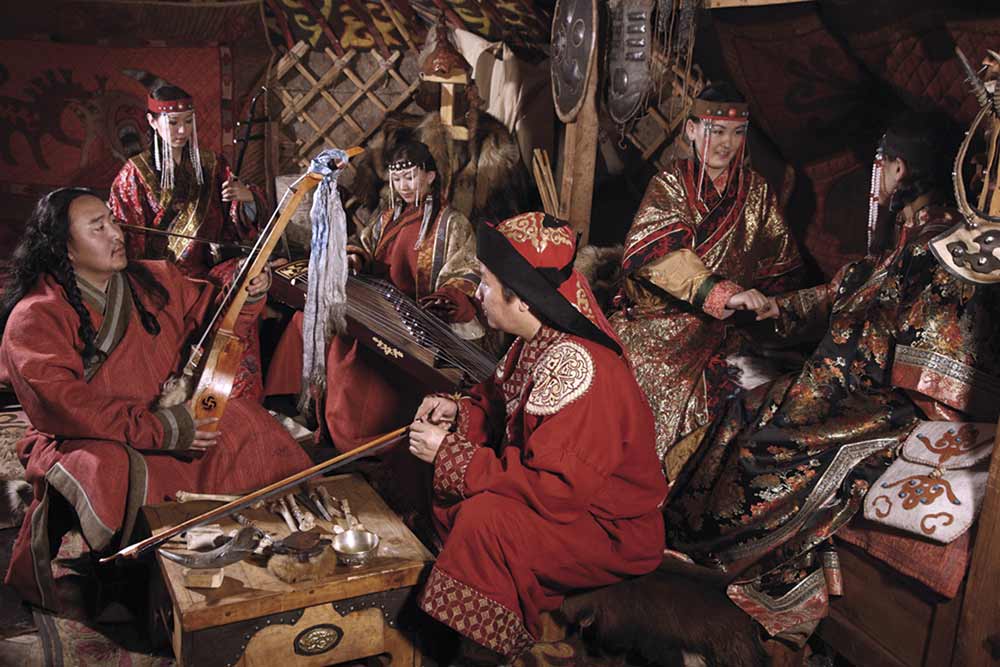
Festivities in the round tent of the princes, accompanied by music
Instruments
- Khun tovshuur - Tovshuur (string instrument)
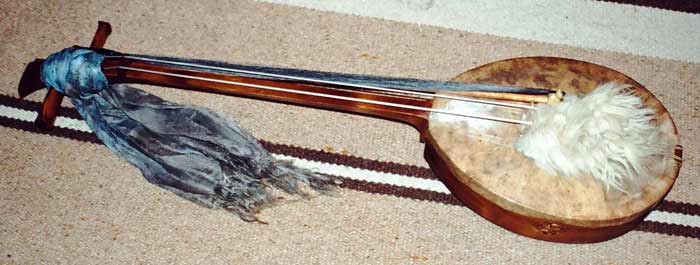 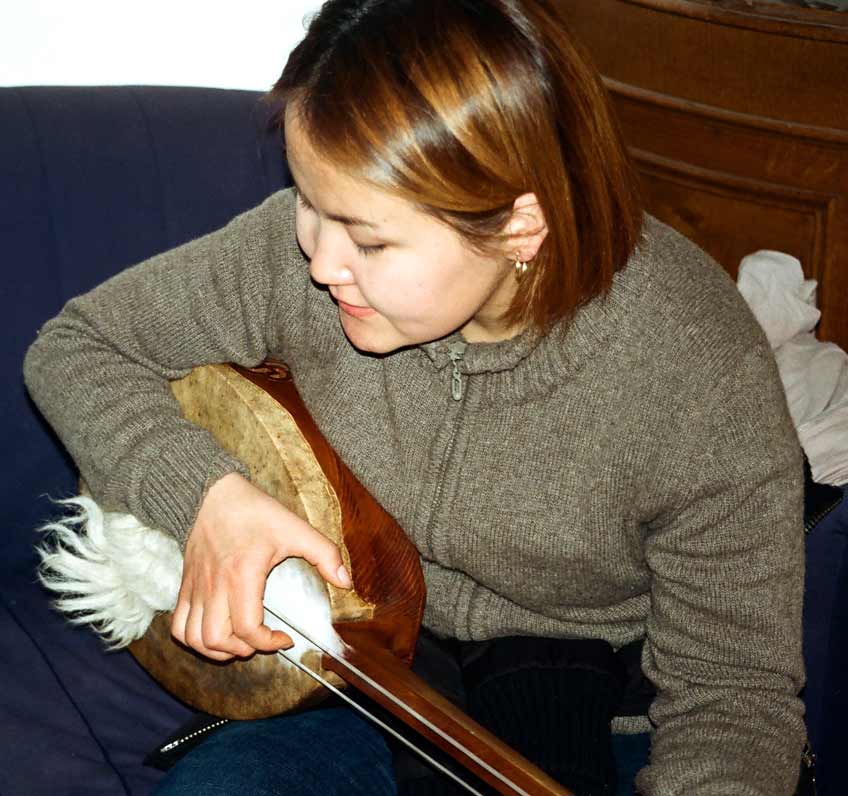
Nomin-Erdene Battulga: female voice, khun tovshuur
The khun tovshuur is a two-stringed instrument similar to the lutes of Tuva, Altai or Kazakhstan. The body and the neck are carved from cedar wood and the body is often coated with the leather of wild animals, camels or goats. In the Mongolian area, the end of the head is formed like a swan (khun = swan) The strings are plaited with horsetail hair and tuned in the interval of a fourth. The lute is often played with a bow made of willow like the ikili a two-string fiddle.
The West Mongols use this lute to accompany the "tuuli" (heroic-epic myths) and the "magtaal" (praise songs).
- Khuuchir (string instrument)
Formerly, the nomads (called "the savages") mainly used the snake skin violin or horsetail violin. The Chinese call it "the Mongol instrument" or "Huk'in". It is tuned in the interval of a fifth and is small or middle sized.
- Morin khuur (string instrument - horse-head-violin)
The morin khuur is a typical Mongolian two-stringed instrument. The body and the neck are carved from wood. The end of the neck has the form of a horsehead and the sound is similar to that of a violin or a cello. The strings are made of dried deer or mountain sheep sinews. It is played with a bow made of willow, stringed with horsetail hair and coated with larch or cedar wood resin.
- Yatga (string instrument)
The yatga is a half-tube zither with a movable bridge. It is constructed as a box with a convex surface and an end bent towards the ground. The strings are plucked and the sound is very smooth. The instrument was considered to be sacrosanct and playing it was a rite, bound to taboos. The instrument was mainly used at court and in monasteries, since strings symbolised the twelve levels of the palace hierarchy.
Shepherds were forbidden to play the twelve-stringed zither, but they were allowed to play the ten-stringed zither, which was also used for interludes during recitations of epics.
- Denshig – small bells (percussion instrument)
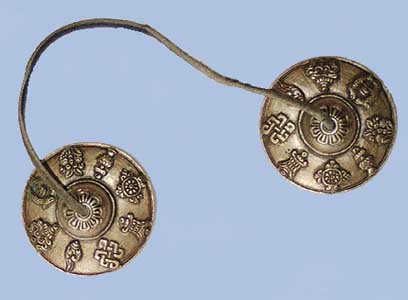
They are only used in the Mongolian and Tibetian region. These are two plainished brass plates, the grips (knobs) of which are connected by means of a small band. On the occasion of services, a lama bangs the two little plates together, thereby producing a sound similar to the touch of a small bell but significantly softer and more melodic.
- Cymbals = small sound plates (Mongolian: Tsan)
They look like small brass plates, in the middle of which there are put knob-like handgrips.
- Rattle (with sheepbone)

Revised by Hermelinde Steiner
PageTop

|
